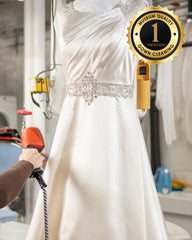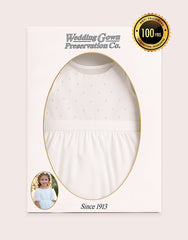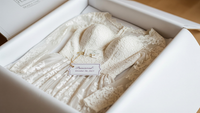What You’ll Learn in This Blog:
-
Why preserving your wedding dress now protects its future emotional and sentimental value
-
The difference between professional preservation and DIY methods (and when to choose each)
-
What fabrics require special care, and why some gowns should never be preserved at home
-
A list of essential materials needed for DIY preservation
-
The biggest storage mistakes to avoid
-
How to choose between a wedding dress preservation box and a garment bag
-
What preservation means not just for the gown, but for the next generation
One day, years from now, your daughter might stand in front of a mirror, slipping into the same gown you wore on the most unforgettable day of your life.
But unless that dress has been carefully protected from time, fabric breakdown, and yellowing, that moment might never happen.
Time isn’t always kind to delicate fabric. Left untouched for too long, even the most beautiful gowns can yellow, stain, or lose their shape. And just like that, the chance to pass it on slips away.
That’s why preserving your dress now—cleaning it gently, boxing it right, and storing it with care—can keep that moment alive, waiting patiently for its second walk down the aisle.
Your Two Preservation Paths: DIY vs. Professional
Professional Preservation (Recommended)
If you’re looking for the safest, most thorough option for preservation, and if your goal is an heirloom, then let the experts take the lead.
Because the professionals know exactly what they’re doing.
What They Do:
-
Inspect every inch of your gown for stains, tears, loose seams, and signs of wear and aging.
-
Use eco-conscious, fabric-safe solvents like SYSTEMK4.
-
Repair seams, embellishments, and hems
-
Pack the dress into an archival-grade, acid-free preservation box designed to last for generations
Cost: Usually between $250 and $1,000
Timeline: 4 to 10 weeks
Bonus: Many preservation companies offer 100-year or lifetime guarantees
What to ask before choosing a company:
-
Do you use acid-free, lignin-free materials?
-
Are solvents environmentally safe (like SYSTEMK4)?
-
Will I receive a written warranty and insured return shipping?
DIY Preservation (Hands-On, Budget-Friendly)
You can preserve your dress on your own if you prefer a hands-on approach, but with care.
However, it is important to have your dress professionally dry cleaned first, because the invisible stains like those from champagne or sweat will cause yellowing over time.
For Surface Spot Cleaning (After Professional Dry-Cleaning):
-
Satin: Dab with cool distilled water. Never rub.
-
Chiffon & Tulle: Handle gently; prone to tearing.
-
Lace: Use a fine mesh over the area before applying any solution.
Your Must-Have Shopping List:
-
Acid-free, archival-quality preservation box.
-
Unbuffered acid-neutral tissue paper.
-
White cotton gloves for handling.
Know When to Call the Pros:
-
If it’s silk, vintage, heavily beaded, or altered.
-
If there’s sentimental damage you don’t want to risk making worse.
Avoid DIY if:
-
Your gown is made of silk or rayon
-
Has heavy embellishments or metallic threads
-
Was vintage or altered with unknown materials
Storage Mistakes to Avoid
-
Never use plastic bags or dry-cleaner wrap
-
Avoid cedar chests (they can discolor fabric)
-
Don’t hang the dress long-term—gravity damages fabric
-
No attics, basements, or rooms with temperature swings
The Step-by-Step Wedding Dress Preservation Process
| Step | What to Do | Insider Tips |
|---|---|---|
| 1. Immediately After The Wedding | Blot the stains gently and air out your dress. | Avoid sealing your dress in any sort of plastic. Take action within 1–3 days. |
| 2. Get It Cleaned Professionally | Photograph and thoroughly document your dress, including all stains. | Ask for sustainable cleaning agents like SYSTEMK4. |
| 3. Inspect And Repair | Mend rips, secure the beadings, and reinforce weak seams. | Consider a bridal tailor for high-end repairs. |
| 4. Box It Safely | Pack in an acid-free box with acid-neutral tissue, padding key areas. | Swap tissue every 2–3 years. |
| 5. Store In A Safe Spot | Choose a cool, dark, and dry location. | Ideal: closet shelf or under-bed storage. Avoid basements and attics. |
| 6. Check It Annually | Gently inspect for yellowing and creases and then refold safely. | Always use gloves and document with photos. |
Box vs. Garment Bag: Which Wins?
Archival Box, hands down.
If you’re looking for a long-term preservation and storage option to pass down your wedding gown to your daughter, then an acid-free archival box is the best option.
A Muslin Garment Bag is ideal only for short-term storage (under 2 years), and it also doesn’t offer full protection from light or moisture.
Fabric Matters: What to Know Before You Store
Different fabrics require different levels of care. Here’s a quick breakdown of the most popular choices of fabric
-
Silk & Rayon: These fabrics are very sensitive, and the stains oxidize very quickly. Always go pro.
-
Polyester Blends: These fabrics are durable enough, which means DIY is possible but with strict care and attention to detail.
-
Beads & Embellishments: Non-metal beads can yellow and corrode over time, so make sure to wrap them separately in acid-neutral tissue.
A Gift for Her Future
One day your daughter might reach for that box and see not just the dress, but also the love, care, and thought that went into preserving it.
She will feel the weight of the vows, the warmth and joy, and the hope that you had for the day she would get married.
So no, preserving your wedding dress isn’t just about saving the garment. It’s about honoring the moment that shaped your life and protecting the possibility of your daughter choosing to wear that dress as-is, or transform it into something new, or simply hold it close as a symbol of your love story.
Clean it. Box it. Store it. Check it annually.
That’s your mantra for making the heirloom story happen.












 200 Business Park, Freehold, NJ 07728
200 Business Park, Freehold, NJ 07728
 (866) 308-8822
(866) 308-8822 info@trustedweddinggownpreservation.com
info@trustedweddinggownpreservation.com
